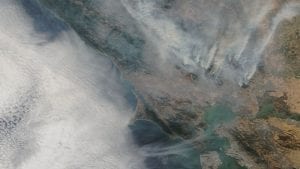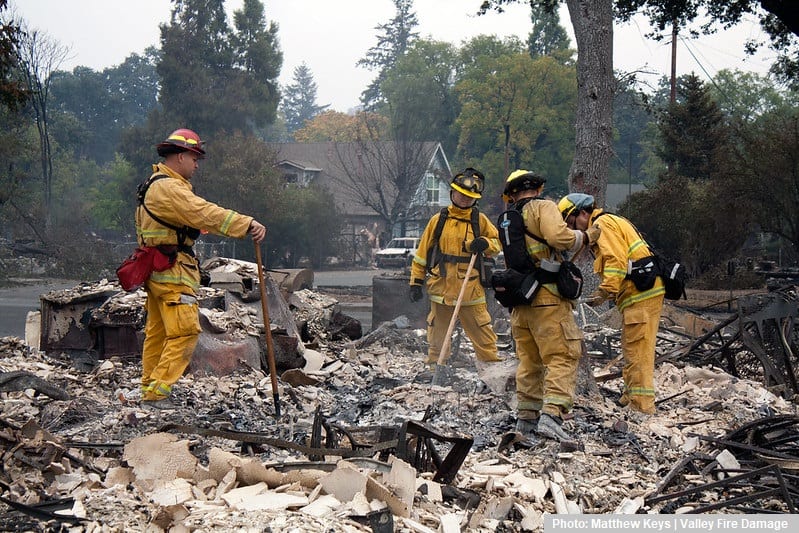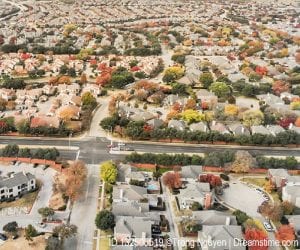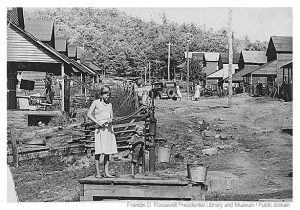The order came through at 3:44am: Evacuation Zone 8 is now a mandatory evacuation area.
With that, I called my family from across the country, hoping they saw the warning. Hoping they were not sleeping. The line picked up, and I tried to keep my voice steady. “Mom. It’s time to go. You need to leave now.”
The Kincade Fire roared through part of my home county in California the weekend of October 27th, prompting the largest evacuation in the county’s modern history. As people fled before dawn, I wondered: “Is this the new normal?” It was only two years ago when the Tubbs Fire ravaged nearby Santa Rosa, killing 22 people with little warning. The next year, the Camp Fire swept through the rural town of Paradise, leveling most of the town and killing 85 people. It was one of the deadliest fires in the U.S. in the last century.

Tubbs Fire, October 2017, MODIS Terra visible satellite image
More People at Higher Risk
Wildfires are not new to California, but climate change is creating drier conditions that fuel more frequent and intense blazes, while suburban sprawl in the U.S.’s most populous state is putting more people in harm’s way. Rural counties are some of the fastest growing areas in the Golden State, which brings new challenges for mitigating and responding to these infernos. From 1990 to 2010, Wilderness Urban Interface areas, places where sprawl spills into rural areas, has increased by 25% according to the most recent Forest Service data. Now, in 2019, 1 in 12 homes in California is at risk for wildfire destruction.
Couple these facts with the reality that since the early 1970s, California has seen a five-time increase in the amount of area burned each year, and we have an urgent situation on our hands. It’s crucial for many organizations, citizens, and levels of government to work together quickly to adopt fire and climate change resiliency plans while simultaneously addressing suburban sprawl, which is putting more people in harm’s way. However, debate ensues about which approach is the right away to protect more lives and homes from these blazes.
Land Development Restrictions vs. Fire Risk Mitigation
California’s population expansion into rural areas has fueled the debate about how to protect these vulnerable communities. The 2018 Camp Fire is one tragic example, where Paradise residents, many of them elderly, had little warning, and traffic jams on the town’s few, 2-lane evacuation routes hindered many escape attempts. The ratio of low evacuation routes to high population density is a risk for numerous rural communities in California. While the city of Paradise is rebuilding and working to create better evacuation planning, the debate, and sometimes elephant in the room, is the question of land development. Many Californians want stricter regulations on where humans can and cannot build. It’s a contentious issue, but recent polling shows that a majority of Californians favor restricting residential and commercial development in wildfire risk areas. Others advocate for mitigation, such as constructing better wildfire-resistant homes. California’s adoption of new building codes for fire-risk zones in 2008 further aims to reduce the risk of homes igniting from an intruding ember. However, even fire-resistant homes can, and have, burned down.

Suburban Sprawl Impacts Community and Firefighter Health
In the aftermath of a wildfire, suburban sprawl can also unleash a range of health concerns for both residents and first responders. As populations settle in more wildfire-prone areas in California, firefighters battling these multi-day infernos are exposed to dangerous chemicals from both houses and land. Unlike firefighters in urban settings, who are outfitted with specific respiratory protection, wildland firefighters don’t have a standard, effective way of protecting their respiratory systems, often using cotton bandanas to shield themselves. As wildfires blaze longer and cover more acreage in California, firefighters’ health are at risk when combating these relentless blazes for days on end. A recent study conducted by UC Berkeley and the San Francisco Firefighters Cancer Prevention Foundation found that 150 firefighters who battled the Tubbs Fire had elevated mercury and PFAS levels in their blood, compounds largely found in household items.
Along with firefighter safety, contamination to the local water supply is growing concern for WUI areas in the aftermath of a wildfire. After the Tubbs and Camp Fires, water tests found benzene, a colorless, odorless carcinogen, in the local water supplies. Long-term exposure to this chemical can lead to cancer and alterations to the immune system. The Paradise Irrigation District issued orders to its residents against drinking the water, and discouraged bathing in it. One year later, the water advisory still stands, although some homes have had the advisory lifted. Officials aren’t sure what exactly caused the benzene contaminations, but some suspect it was pipe depressurization during the fires, pulling in ash-soaked water and gases from around the pipes.
The Need for Quick, Collaborative Action
As climate change fuels more frequent and stronger fires in California, the question remains: should we restrict where people can build? If so, what impact would that have on the state’s housing crisis, where high rents and housing shortages spur development further out. If we don’t restrict development into WUI areas, how do we help these populations prepare for these fires, and reduce the risk of harm to life and property? These are questions that California, and many parts of the U.S., must quickly act on.
Image credits: Tubbs fire (NASA); Firefighters in debris (Valley Fire Damage – Creative Commons – Middletown, California by Matthew Keys is licensed under CC BY-ND 2.0)




